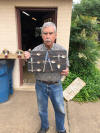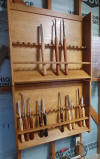
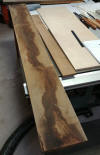 Richard
Hash -
I was getting tired of leaving my lathe tools just lying around wherever
I happen to last set them down and decided it was time for a couple of
storage racks, one for longer tools and one for shorter ones, with
plenty of room to grow. I had a single 25-yr old "rat-pee oak" board
left (named because it was stored in a barn and was given a certain
patina and charm by local critters, see photo). I believe its post oak
(quercus stellata).
Richard
Hash -
I was getting tired of leaving my lathe tools just lying around wherever
I happen to last set them down and decided it was time for a couple of
storage racks, one for longer tools and one for shorter ones, with
plenty of room to grow. I had a single 25-yr old "rat-pee oak" board
left (named because it was stored in a barn and was given a certain
patina and charm by local critters, see photo). I believe its post oak
(quercus stellata).
Took me awhile to figure out the right angles
and distances so the tools would lean back just enough to keep them
secure, and the slanted bottom shelf is to hopefully lessen chips/dust.



Rick Spacek
My wife ask me to make her some plaques with butterflies
Wilbert Allums
Two cutting boards from # 2 pine.
Bob Wink
Bob shows his latest folk art creations. Anyone
missing a stringer?
These trivets and coasters were made from pieces left over from previous
projects. They were just cluttering up my bench so converted to
something useful.
My wife saw this design in a furniture catalogue we received and wanted
it for our bedroom.
Cabinet is made of reclaimed pine from some
old shelving/cabinet that were in my garage so it only cost me time,
paint and hardware.
Gary Rowen crafted this patio table out of cedar from Home Depot.
Gary preferred to leave it in its octagonal shape rather than
make the top a circle. The
table is stained with Behr Semi-Transparent Weather Proofing Redwood
Stain and topped with spar urethane. The table is from a design by Steve
Ramsey, Woodworking for Mere Mortals, (Steve’s YouTube channel).
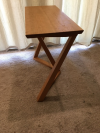



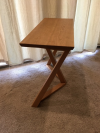 Mike Hardy
Mike Hardy
This is my new '200 Lex' Side Table. It is cherry finished with Osmo
Polyx Oil (first time using that). The dimensions are 30.0" x 13" x
24.5". The idea for the base came from a table I saw on the 'gallery
floor' of the New York City Design Center (which is at 200 Lexington in
Manhattan) where many of the companies in the building display some
pieces. It is also heavily influenced by a table by Thos. Moser. The
Thos. Moser New York Showroom had just moved to the NYC Design Center,
which is why I was there.
Hi guys. Here is a bench I made from parts of a piano that was
demolished. The worst part was stripping off the old finish.
(varnish?) I used Citristrip first. After one hour, very
little progress, so I reapplied, covered with plastic, and left on
overnight. By then, not only was it dried nearly hard, like old
putty, but it still did not remove all the old finish. Following
instructions, I used an abrasive pad with more Citristrip, then cleaned
with paint stripper After Wash, then cleaned that off with mineral
spirits. I still had to sand off the remaining patches of old
finish! Unfortunately, since everything was veneered, I was afraid
to just sand off the old finish and go right through the veneer.
Anyway, after many hours, I used iron on edge veneer, a MInwax mahogany
stain, and water based urethane.
The construction is all mortise and tenon, except for screwed on buttons
(with slots for wood movement,) to hold the seat securely. I had
left small gaps on the corners to allow movement, and these kept the
seat from rattling, as well as holding it flat. This is
constructed like a table, with an apron attached to the legs. I
extended the legs and added the upper side rails with handles, which
sandwiched the seat between the apron and these rails. Making the
legs 3/4" by 2" left plenty of room for the mortise and tenon joints
from the side and front apron parts. Even though everything is
from 3/4" stock, the construction made it quite light weight, yet
amazingly rigid and strong.
I have more projects to make from piano parts, but I refuse to strip the
finish again...awful!





 Dave VanDewerker
Dave VanDewerker
I made a few Texas bowls, each about 15×15 inches and the depths vary
based on the thickness of the wood.
One is Cherry and White Oak about 2" deep, one is Padauk and White Oak
about 3" deep and the third is Maple and Mahogany and about 2-1/4 inches
deep. These I finished with a couple coats of shellac sealer and 3 coats
of water based poly.
I made this box from the same piano demolition as the bench. I
also used solid mahogany for the sides, but the top and bottom are
salvaged pieces. This time I just did some sanding, and nothing on
the inside of the lid, to preserve the original decal as a keepsake.
Box joints for the corners, mortised grooves for the bottom, and cut the
piano hinge to add a rear hinge. This makes a very unusual double
hinged lid. I stained the sides darker with a red mahogany Minwax
stain, and finished with Minwax water based urethane. The handles
I cut out on the band saw, and attached with screws. I believe
they are real African ebony, as they are from a very old scrap of wood,
which is so dense it sinks in water.
Three bowls: Water oak, 10" x 3 1/2", a very thin walled bowl of Osage
Orange, 5" x 2", and an Osage Orange plate, of two pieces book matched
to show off the red and brown spots, 7 3/4" x 1 1/4"
************************************************************************************************************
1Wink Wood: Bob Wink lives near a commercial woodworking
facility that gives away what they consider to be scrap pieces of
commercial grade plywood and misc hard woods. Bob rescues this wood
before a Grinch comes and takes the scrap for firewood. Many
woodworkers in WWCH have made good use of these excess pieces by making
jigs, toys, and incorporating them into their projects as you’ve seen in
many Show n Tell projects. This source of wood is what has become known
as “Wink” wood
Photos and descriptions by respective contributors except for some commentary by the Webmaster

